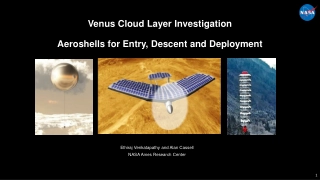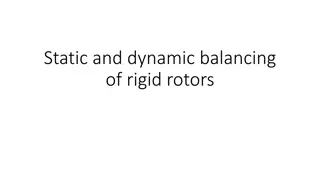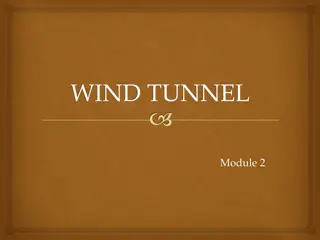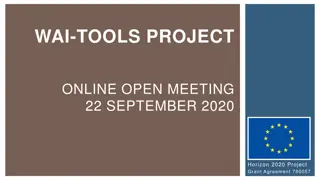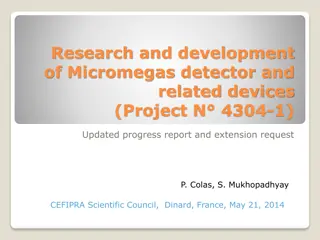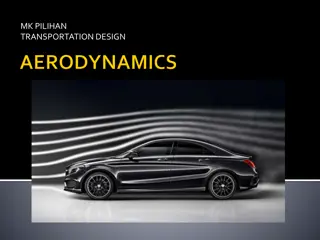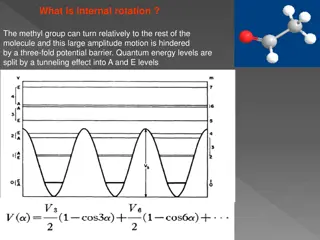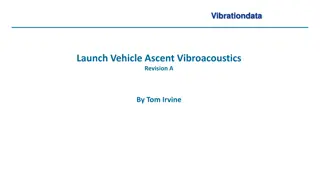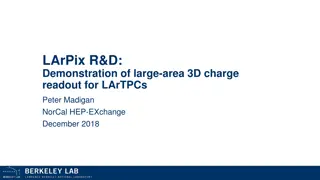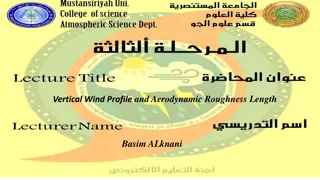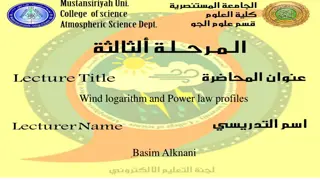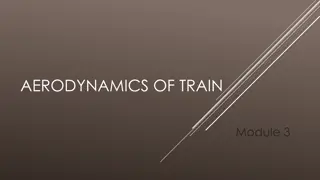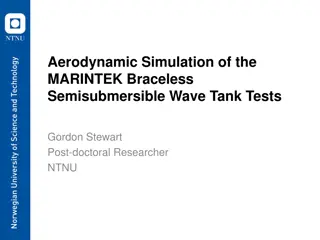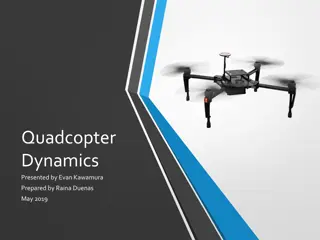AVATAR Project: Advancements in Aerodynamic Tools for Large Rotors
The AVATAR project, funded by the European Union's Seventh Programme, focuses on advancing aerodynamic tools for large wind turbines, specifically in the 10-20MW range. Led by a consortium of top research institutions and industry partners, AVATAR aims to elevate aerodynamic and fluid-structure models to accommodate the challenges posed by scaling up turbine sizes for offshore applications. The motivation stems from the need to increase capacity factors, optimize load efficiency, and reduce Levelized Cost of Energy (LCOE) through improved aerodynamic designs. The project, active from November 1st, 2013 to December 31st, 2017, addresses critical aerodynamic considerations such as Reynolds number effects, compressibility effects, airfoil thickness, and flow characteristics, with the goal of designing more efficient and effective 10MW+ turbines.
Download Presentation

Please find below an Image/Link to download the presentation.
The content on the website is provided AS IS for your information and personal use only. It may not be sold, licensed, or shared on other websites without obtaining consent from the author.If you encounter any issues during the download, it is possible that the publisher has removed the file from their server.
You are allowed to download the files provided on this website for personal or commercial use, subject to the condition that they are used lawfully. All files are the property of their respective owners.
The content on the website is provided AS IS for your information and personal use only. It may not be sold, licensed, or shared on other websites without obtaining consent from the author.
E N D
Presentation Transcript
www.eera-avatar.eu AVATAR project Advanced Aerodynamic Tools for lArge Rotors Gerard Schepers November 30h, 2017 WindEurope Event Amsterdam, the Netherlands This project has received funding from the European Union s Seventh Programme for research, technological development and demonstration under grand agreement No FP7-ENERGY-2013-1/n 608396 .
EU FP7 Project initiated by EERA 1. Energy Research Centre of the Netherlands, ECN (Coordinator) 2. Delft University of Technology, TUDelft 3. Technical University of Denmark, DTU 4. Fraunhofer IWES 5. University of Oldenburg, Forwind 6. University of Stuttgart, USTUTT 7. National Renewable Energy Centre, CENER 8. University of Liverpool/University of Glasgow, ULIV/UoG 9. Centre for Renewable Energy Sources and Saving, CRES 10.National Technical University of Greece, NTUA 11.Politecnico di Milano, Polimi 12.GE Global Research, Zweigniederlassung der General Electric Deutschland Holding GmbH, GE 13.LM Wind Power, LM FP7-ENERGY-2013-1/ n 608396 20-11-2024 2
AVATAR presentations 09.30-09.30 Introduction and main achievements, Gerard Schepers (ECN) 09.30-09.45 Aerodynamic response modelling of complex and turbulent inflow, Niels Sorensen(DTU) FP7-ENERGY-2013-1/ n 608396
Period Project period: November 1st2013- December 31st2017 FP7-ENERGY-2013-1/ n 608396 4
Main motivation for AVATAR: Aerodynamics of large wind turbines (10-20MW) Upscaling turbine size for off-shore applications: Higher capacity factors and more hours at full (constant) load The LCOE is relatively insensitive to the size of a turbine So Upscaling to 10MW+ is an option to reduce the LCOE However .. FP7-ENERGY-2013-1/ n 608396 20-11-2024 5
Main motivation for AVATAR: Aerodynamics of large wind turbines (10-20MW) We simply didn t know if aerodynamic models were good enough to design 10MW+ turbines 10MW+ rotors violate assumptions in aerodynamic tools, e.g.: Reynolds number effects, Compressibility effects Thick(er) airfoils Flow transition and separation, (More) flexible blades Flow devices FP7-ENERGY-2013-1/ n 608396 20-11-2024 6
Avatar: Main objective 10MW+ designs fell outside the validated range of state of the art tools. Objective of AVATAR: To bring the aerodynamic and fluid-structure models to a next level and calibrate them for all relevant aspects of large (10MW+) wind turbines FP7-ENERGY-2013-1/ n 608396 20-11-2024 7
Avatar: Work procedure Problem: No 10 MW turbines are on the market yet for validation. 1. 2. Validate submodels against (mainly wind tunnel) experiments Cross-comparison of model results o In the project we have many models which range from computational efficient engineering tools to high fidelity but computationally expensive tools o Engineering tools are needed in industrial design codes 1) and2) o High fidelity models (and intermediate models) feed information towards engineering models 1) 2) J.G. Schepers Engineering models in wind energy aerodynamics, (2012). M. Kloosterman, DNV-GL, AVATAR Advisory Board FP7-ENERGY-2013-1/ n 608396 20-11-2024 8
One Highlight: Measurements in DNW pressurized tunnel DNW-HDG model, c=15 cm Measurements up to Re = 15M (and low M) DU00-W-212 selected as common airfoil o Also measured by: LM up to RE=6M Forwind at controlled turbulent conditions up to Re = 1M Results are brought into a blind test o Measurements compared with calculations o Blind test included participants outside project Summary of the Blind Test Campaign to predict the High Reynolds number Ozlem Ceyhan, Oscar Pires, Xabier Munduate, Niels N. Sorensen, Alois Peter Schaffarczyk, Torben Reichstein, Konstantinos Diakakis, Giorgos Papadakis, Elia Daniele, Michael Schwarz, Thorsten Lutz, and Raul Prieto 35th Wind Energy Symposium. Grapevine, Texas. performance of DU00-W-210 airfoil FP7-ENERGY-2013-1/ n 608396
Full CFD calculations vs measurements Effect in Blade Design parameter: Cl/Cd 180 180 Exp DTU-Ellipsys NTUA-MaPFlow Kiel-TAU F-I-OpenFOAM UoG-HMB Exp DTU-Ellipsys NTUA-MaPFlow Kiel-TAU- F-I-OpenFOAM UoG-HMB Test1 Rey=3 106 Ti3 ( 0.09% ) Test3 Rey=6 106 Ti3 ( 0.2% ) 160 160 140 140 120 120 100 100 Cl/Cd Cl/Cd 80 80 60 60 40 40 20 20 0 0 -5 0 5 10 15 -5 0 5 10 15 Alpha Alpha FP7-ENERGY-2013-1/ n 608396
Full CFD calculations vs measurements Effect in Blade Design parameter: Cl/Cd 180 180 Exp DTU-Ellipsys NTUA-MaPFlow Kiel-TAU F-I-OpenFOAM Test7 Rey=15 106 Ti3 ( 0.33% ) Test5 Rey=9 106 Ti3 ( 0.24% ) Exp DTU-Ellipsys NTUA-MaPFlow Kiel-TAU F-I-OpenFOAM 160 160 140 140 120 120 100 100 Cl/Cd Cl/Cd 80 80 60 60 40 40 20 20 0 0 -5 0 5 10 15 -5 0 5 10 15 Alpha Alpha FP7-ENERGY-2013-1/ n 608396
Blind test: main conclusion cl/cdpeak is sharp at Re=3M, flattens towards Re =15M eNboundary layer transtion method performs well at all Reynolds numbers Correlation based transition method (state of the art in many CFD tools!) deficient at high Reynolds numbers1) New version of correlation based transition model is developed with better performance 2) 1) Niels N. S rensen et al Prediction of airfoil performance at high Reynolds numbers EFMC 2014, Copenhagen 17-20 Sept 2014 2) S. Colonia et al Calibration of the equation transition model for High Reynolds flows at low Mach To be published at the Science of Matking Torque, October 2016 FP7-ENERGY-2013-1/ n 608396
Avatar: Main achievements Many model improvements and lessons learned (e.g. modelling of high Reynolds number effects, modelling of flow devices, coupled aero- elastic/free vortex wake models, best practice guidelines on model use) Databases of (wind tunnel) measurements Databases of high fidelity model results Designs of 10 MW Reference Wind turbines, Etc etc Models are improved and implemented in codes with which 10 MW+ turbines can be designed with confidence as a way to reduce LCOE For more information: http://www.eera-avatar.eu/ FP7-ENERGY-2013-1/ n 608396 20-11-2024 13
Avatar: Main recommendation Far too little experimental validation material! A public aerodynamic (aero-elastic) field experiment on a large- scale wind turbine using the most advanced aerodynamic (and acoustic) measurement techniques is urgently needed A design for such experiment is included in AVATAR Experiment will be detailed in IEA Task 29 Aerodynamic measurements FP7-ENERGY-2013-1/ n 608396 20-11-2024 14
Consortium Coordinator: Partners in alphabetical order: FP7-ENERGY-2013-1/ n 608396
Thank you for your attention This project has received funding from the European Union s Seventh Programme for research, technological development and demonstration under grand agreement No FP7-ENERGY-2013-1/n 608396 .

